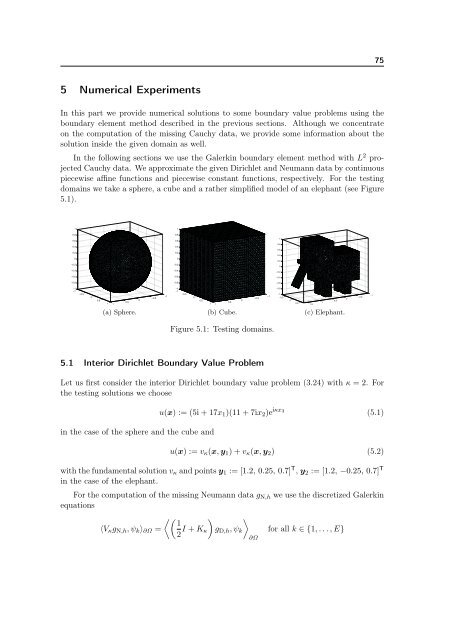The Boundary Element Method for the Helmholtz Equation ... - FEI VÅ B
The Boundary Element Method for the Helmholtz Equation ... - FEI VÅ B The Boundary Element Method for the Helmholtz Equation ... - FEI VÅ B
755 Numerical ExperimentsIn this part we provide numerical solutions to some boundary value problems using theboundary element method described in the previous sections. Although we concentrateon the computation of the missing Cauchy data, we provide some information about thesolution inside the given domain as well.In the following sections we use the Galerkin boundary element method with L 2 projectedCauchy data. We approximate the given Dirichlet and Neumann data by continuouspiecewise affine functions and piecewise constant functions, respectively. For the testingdomains we take a sphere, a cube and a rather simplified model of an elephant (see Figure5.1).110.80.80.60.610.40.20.40.20.80.60.4000.2−0.2−0.20−0.4−0.4−0.2−0.6−0.6−0.4−0.8−0.8−0.6−1−1−0.500.500.51 1(a) Sphere.−0.5−1−1−1−0.500.50.51 1(b) Cube.0−0.5−1−0.8−1−0.500.500.511.5(c) Elephant.−0.5−1Figure 5.1: Testing domains.5.1 Interior Dirichlet Boundary Value ProblemLet us first consider the interior Dirichlet boundary value problem (3.24) with κ = 2. Forthe testing solutions we choosein the case of the sphere and the cube andu(x) := (5i + 17x 1 )(11 + 7ix 2 )e iκx 3(5.1)u(x) := v κ (x, y 1 ) + v κ (x, y 2 ) (5.2)with the fundamental solution v κ and points y 1 := [1.2, 0.25, 0.7] T , y 2 := [1.2, −0.25, 0.7] Tin the case of the elephant.For the computation of the missing Neumann data g N,h we use the discretized Galerkinequations 1⟨V κ g N,h , ψ k ⟩ ∂Ω =2 I + K κ g D,h , ψ k for all k ∈ {1, . . . , E}∂Ω
- Page 36 and 37: 24 2 Helmholtz Equationand due to p
- Page 38 and 39: 26 2 Helmholtz Equationand thus l
- Page 41 and 42: 293 Boundary Integral EquationsAt t
- Page 43 and 44: 313.1 Single Layer Potential Operat
- Page 45 and 46: 33For the jump of the Neumann trace
- Page 47 and 48: 35with the surface curl operatorcur
- Page 49 and 50: 37The following theorems are standa
- Page 51 and 52: 39u ∈ H 1 (Ω, ∆+κ 2 ) if and
- Page 53 and 54: 41Another approach to computing the
- Page 55 and 56: 433.5.3 Interior Mixed Boundary Val
- Page 57 and 58: 45respectively.The unique solvabili
- Page 59: 47with an unbounded domain Ω ext :
- Page 62 and 63: 50 4 Discretization and Numerical R
- Page 64 and 65: 52 4 Discretization and Numerical R
- Page 66 and 67: 54 4 Discretization and Numerical R
- Page 68 and 69: 56 4 Discretization and Numerical R
- Page 70 and 71: 58 4 Discretization and Numerical R
- Page 72 and 73: 60 4 Discretization and Numerical R
- Page 74 and 75: 62 4 Discretization and Numerical R
- Page 76 and 77: 64 4 Discretization and Numerical R
- Page 78 and 79: 66 4 Discretization and Numerical R
- Page 80 and 81: 68 4 Discretization and Numerical R
- Page 82 and 83: 70 4 Discretization and Numerical R
- Page 84 and 85: 72 4 Discretization and Numerical R
- Page 88 and 89: 76 5 Numerical Experimentsand the m
- Page 90 and 91: 78 5 Numerical Experimentsand the m
- Page 92 and 93: 80 5 Numerical ExperimentsE N Err D
- Page 94 and 95: 82 5 Numerical ExperimentsIn Tables
- Page 96 and 97: 84 5 Numerical Experiments10.80.60.
- Page 98 and 99: 86 5 Numerical Experimentswith the
- Page 101 and 102: 89References[1] ADAMS, Robert A.; F
755 Numerical ExperimentsIn this part we provide numerical solutions to some boundary value problems using <strong>the</strong>boundary element method described in <strong>the</strong> previous sections. Although we concentrateon <strong>the</strong> computation of <strong>the</strong> missing Cauchy data, we provide some in<strong>for</strong>mation about <strong>the</strong>solution inside <strong>the</strong> given domain as well.In <strong>the</strong> following sections we use <strong>the</strong> Galerkin boundary element method with L 2 projectedCauchy data. We approximate <strong>the</strong> given Dirichlet and Neumann data by continuouspiecewise affine functions and piecewise constant functions, respectively. For <strong>the</strong> testingdomains we take a sphere, a cube and a ra<strong>the</strong>r simplified model of an elephant (see Figure5.1).110.80.80.60.610.40.20.40.20.80.60.4000.2−0.2−0.20−0.4−0.4−0.2−0.6−0.6−0.4−0.8−0.8−0.6−1−1−0.500.500.51 1(a) Sphere.−0.5−1−1−1−0.500.50.51 1(b) Cube.0−0.5−1−0.8−1−0.500.500.511.5(c) Elephant.−0.5−1Figure 5.1: Testing domains.5.1 Interior Dirichlet <strong>Boundary</strong> Value ProblemLet us first consider <strong>the</strong> interior Dirichlet boundary value problem (3.24) with κ = 2. For<strong>the</strong> testing solutions we choosein <strong>the</strong> case of <strong>the</strong> sphere and <strong>the</strong> cube andu(x) := (5i + 17x 1 )(11 + 7ix 2 )e iκx 3(5.1)u(x) := v κ (x, y 1 ) + v κ (x, y 2 ) (5.2)with <strong>the</strong> fundamental solution v κ and points y 1 := [1.2, 0.25, 0.7] T , y 2 := [1.2, −0.25, 0.7] Tin <strong>the</strong> case of <strong>the</strong> elephant.For <strong>the</strong> computation of <strong>the</strong> missing Neumann data g N,h we use <strong>the</strong> discretized Galerkinequations 1⟨V κ g N,h , ψ k ⟩ ∂Ω =2 I + K κ g D,h , ψ k <strong>for</strong> all k ∈ {1, . . . , E}∂Ω



